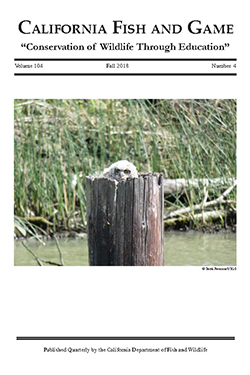
The latest two issues of California Fish and Game, CDFW’s long-running scientific journal, are now available online.
Issue 104(3) features a rather dignified-looking desert spiny lizard (Sceloporus magister) on the cover. It is one of 15 species captured and documented by Cummings et. al in Biodiversity of amphibians and reptiles at the Camp Cady Wildlife Area, Mojave Desert, California and comparison with other desert locations. The paper’s eight authors spent months in the Mojave desert location, trapping and identifying its inhabitants. The finding were combined with a review of scientific literature to document the biological diversity of the area in comparison to other desert habitats.
Also in Issue 104(3):
- Annual and seasonal variation, relative abundance, and effects of managed flows on timing of migration in Brown Trout (Salmo trutta) in the upper Trinity River, by Sullivan and Hilemen, challenges a previous study suggesting that brown trout populations are increasing in the upper Trinity River and are having a negative impact on native juvenile anadromous salmonids. The authors assert that previous trapping data suggest a behavioral response to managed flow regimes rather than an increasing population. Further, they provide management recommendations to determine whether the removal of brown trout—an important economic sport fishery resource—is necessary and has the potential to be successful.
- Geographic range and biology of Spinyeye Rockfish (Sebastes spinorbis Chen, 1975), an endemic species to the Gulf of California, Mexico, by Acevedo-Cervantes et. al. The authors add to the existing knowledge of a marine species that is currently not a fishing target and about which little is known.
Issue 104(4)’s cover photo illustrates the article Ground-nesting great horned owl in Suisun Marsh, California. Skalos et. al provide vivid descriptions and photographs of great horned owl nest sites, ranging from non-native eucalyptus trees to man-made structures (such as the dock piling shown in the cover photo) and even ground nests. Though great horned owl nest sites are known to be diverse, little documentation exists to support some of these observations. In fact, Skalos et. al’s ground nest observation is the first documented case in California.
Also in Issue 104(4):
- Prey of neonate leopards Sharks in San Francisco Bay, California by R. Russo. The leopard shark has been the focus of several studies documenting the diet of juvenile through adult stage animals. The author examined the stomach contents of neonate leopard sharks and found that small, easily accessible prey items such as bay shrimps and polychaete worms are important for rapid growth of leopard sharks during the first year of life.
- Within-Talus temperatures are not limiting for pikas in the Northern Sierra Nevada, by Wright and Stewart. Pikas are small herbivores related to rabbits that live in fields of broken rock (talus) in the mountains of western North America. Researchers examined potentially suitable talus habitats at various elevations in the northern Sierra Nevada. Their findings suggest that the cooler temperatures provided by talus is not sufficient to sustain pikas. The aboveground air and surface temperatures, rather than temperatures within talus, pose a greater challenge to pika survival.
California Fish and Game provides important contributions to the existing body of scientific knowledge. First published in 1914, California Fish and Game is the longest continuously published scientific journal. For more information and other back issues, please visit CDFW’s website.
CDFW Photos.
Media Contact:
Lorna Bernard, CDFW Communications, (916) 322-8911